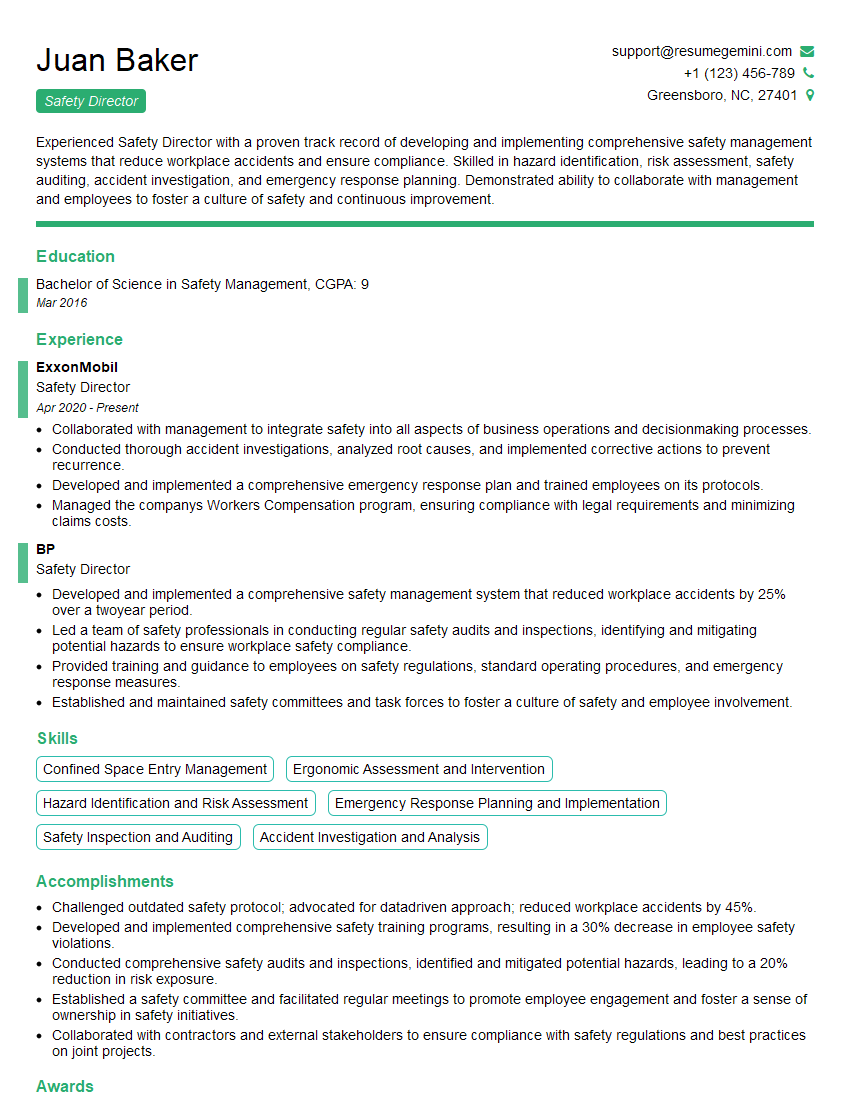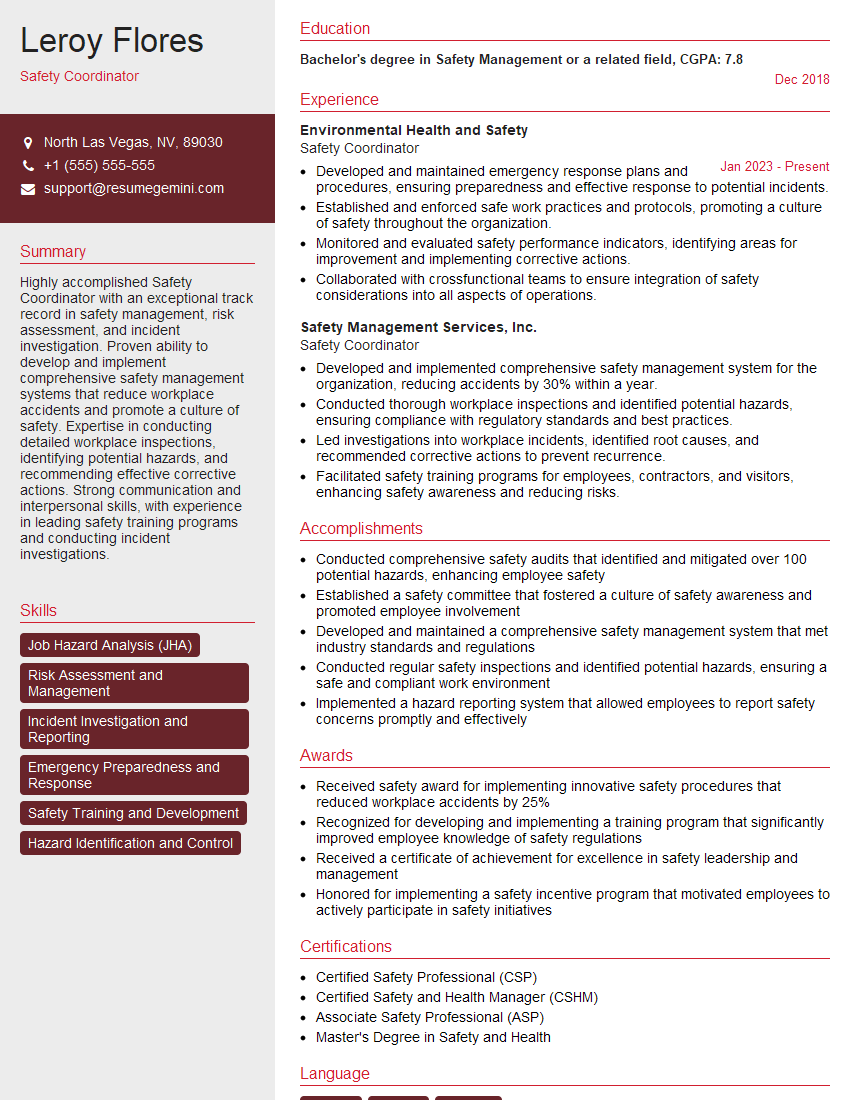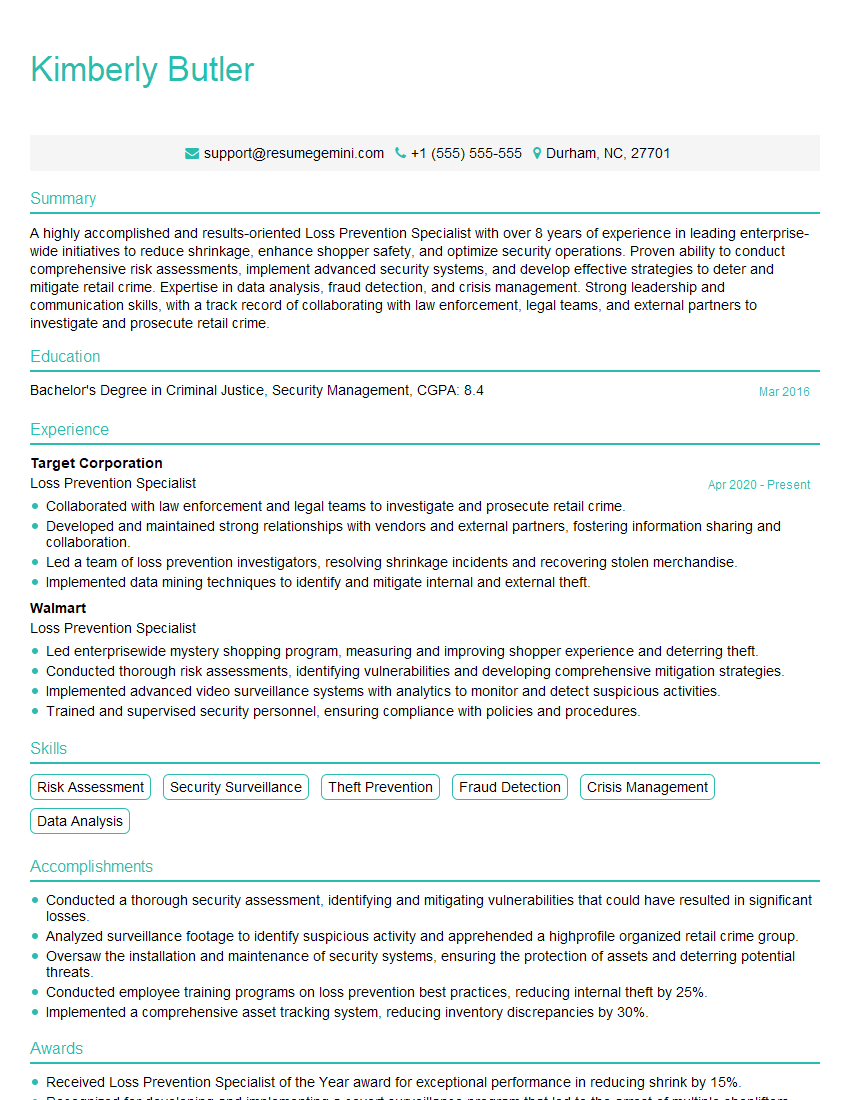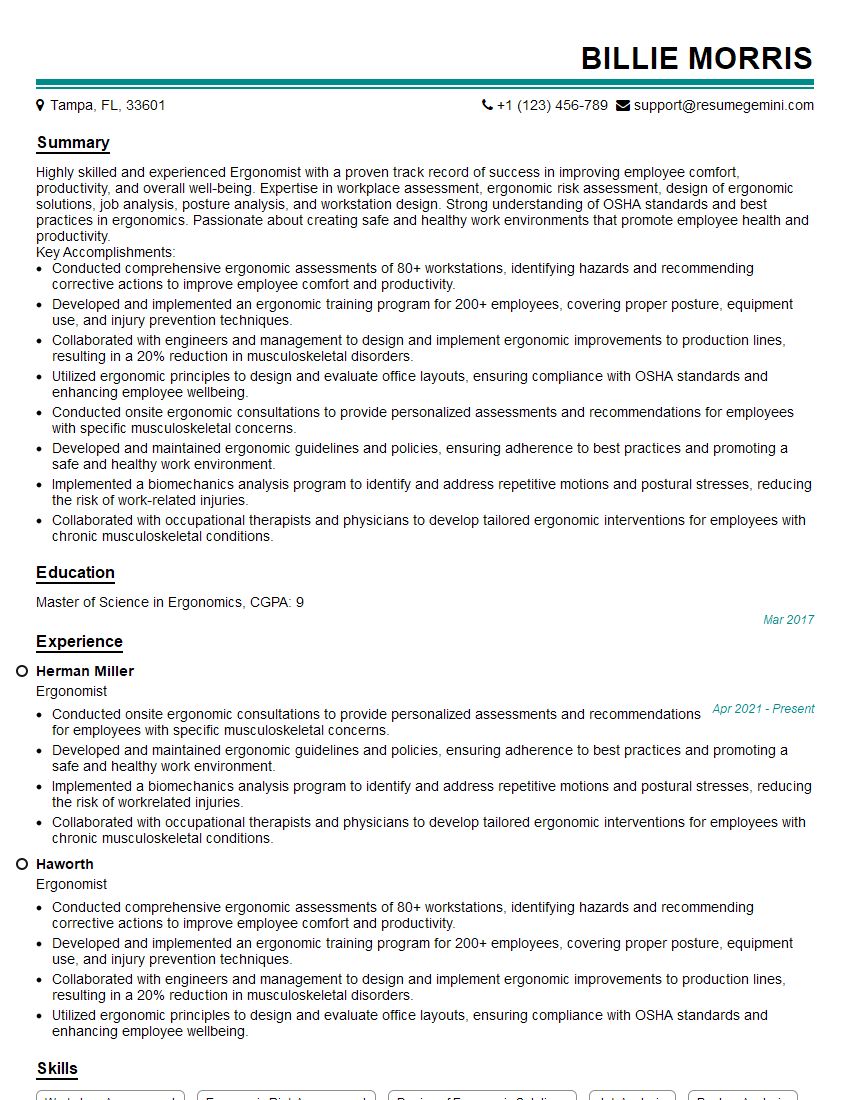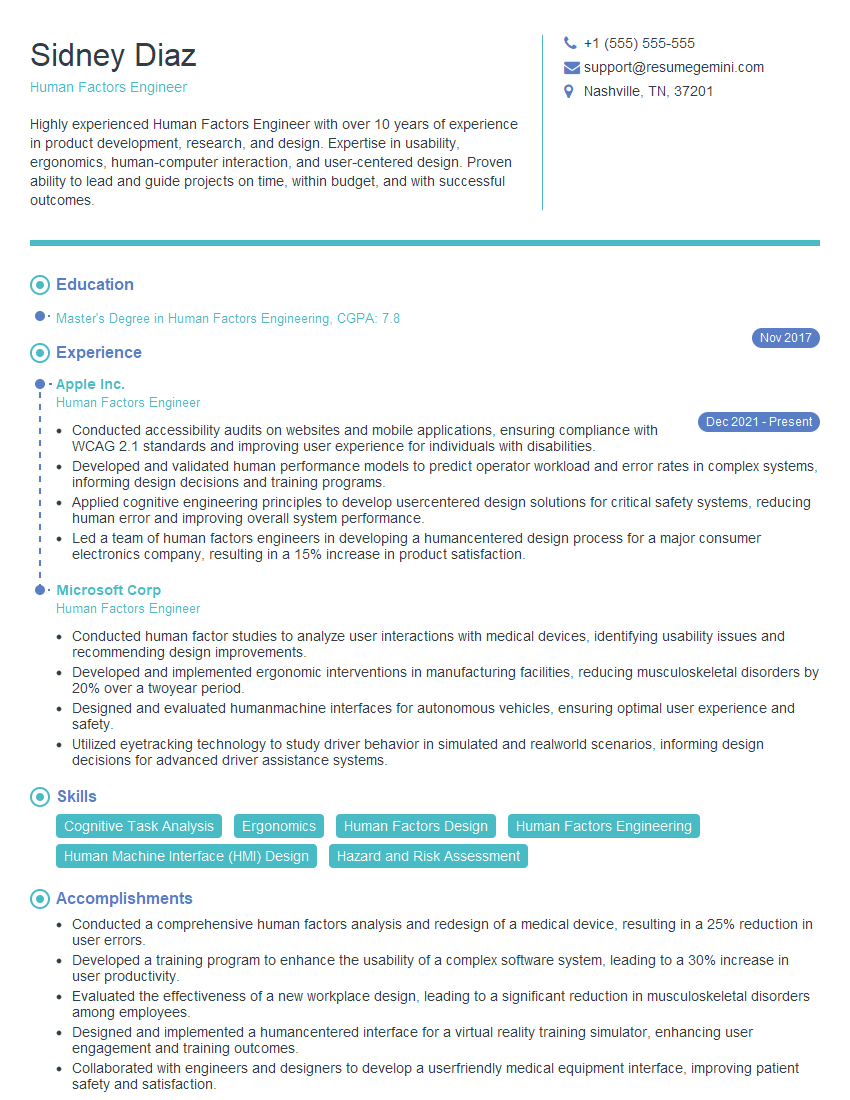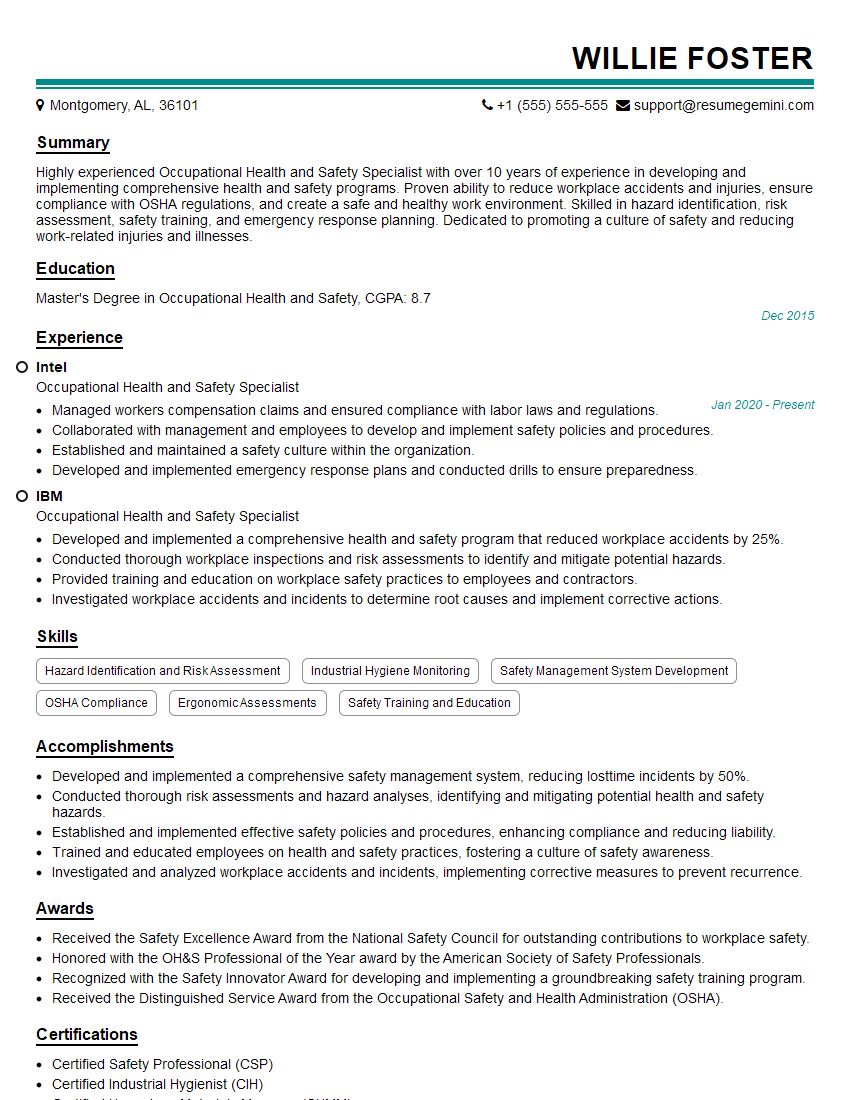Feeling uncertain about what to expect in your upcoming interview? We’ve got you covered! This blog highlights the most important Fall Prevention and Safety interview questions and provides actionable advice to help you stand out as the ideal candidate. Let’s pave the way for your success.
Questions Asked in Fall Prevention and Safety Interview
Q 1. Describe your experience with OSHA’s fall protection standards.
My experience with OSHA’s fall protection standards is extensive. I’ve spent years working in safety management, directly applying and interpreting these regulations in various high-risk industries, including construction, manufacturing, and telecommunications. I’m intimately familiar with the requirements of 29 CFR 1926 Subpart M, which covers fall protection in construction, and related standards applicable to other industries. This includes a deep understanding of the requirements for fall protection systems, training programs, hazard assessments, and record-keeping. I’ve been responsible for developing and implementing fall protection plans, conducting training sessions, and performing regular inspections to ensure compliance. My experience also encompasses investigating fall incidents, determining root causes, and implementing corrective actions to prevent future occurrences. I’ve regularly updated my knowledge to stay current with any revisions or changes to OSHA regulations.
Q 2. What are the different types of fall protection systems?
Fall protection systems are categorized into several types, each suited to different working conditions and hazards. These include:
- Guardrail Systems: These offer a physical barrier to prevent falls from heights. They typically consist of a top rail, mid-rail, and toe board.
- Safety Net Systems: Nets are installed beneath work areas to catch workers in the event of a fall. They are most effective for lower heights and require careful planning and installation.
- Personal Fall Arrest Systems (PFAS): These systems consist of a harness, anchor point, lanyard, and potentially a shock absorber. They arrest a fall and prevent a worker from hitting the ground. PFAS include different types of lanyards, such as self-retracting lifelines (SRLs) and shock-absorbing lanyards.
- Positioning and Restraint Systems: Positioning systems keep a worker in a safe position, while restraint systems prevent a worker from reaching a fall hazard area. These systems are often used in window cleaning or other specialized work.
- Fall-arresting scaffolding: Scaffolds should have guardrails and toe boards and should be built according to OSHA standards. Some specialized scaffolding systems also include integrated fall protection mechanisms.
The choice of system depends heavily on the specific work environment and risk assessment.
Q 3. Explain the hierarchy of fall protection controls.
The hierarchy of fall protection controls is a fundamental principle in fall prevention, prioritizing the most effective and safest methods. It’s based on eliminating hazards entirely, rather than solely relying on personal protective equipment (PPE). The hierarchy is as follows:
- Elimination: Completely remove the fall hazard. This might involve redesigning a work area to remove elevated work surfaces.
- Substitution: Replace the hazardous task with a safer alternative. For instance, using ground-based equipment instead of working at heights.
- Engineering Controls: Implement physical changes to control the hazard, such as installing guardrails or safety nets. These controls are often more effective and reliable than PPE.
- Administrative Controls: Develop procedures and training to minimize the risk of falls, including work permits and safe work practices.
- Personal Protective Equipment (PPE): The last line of defense, including harnesses, lanyards, and other fall arrest equipment. PPE should only be used when other control measures are insufficient.
Following this hierarchy ensures the most robust and reliable fall protection strategy.
Q 4. How do you conduct a fall hazard assessment?
A thorough fall hazard assessment is critical to developing an effective fall protection plan. It involves a systematic evaluation of a workplace to identify potential fall hazards and determine the appropriate control measures. My approach includes the following steps:
- Walkthrough Inspection: A physical survey of the worksite, identifying all potential fall hazards, such as open edges, holes, and unguarded surfaces. I look for both obvious and subtle risks.
- Documentation: Detailed documentation of identified hazards, including photographs and precise locations. I record the height of the fall hazard, types of surfaces and any existing control measures.
- Risk Assessment: Determining the likelihood and severity of a fall, considering factors like the height of the fall, the surface below, and the presence of any obstacles. I use a risk matrix to quantify the potential danger.
- Control Selection: Choosing the appropriate fall protection measures based on the hierarchy of controls. This is tailored to each specific identified hazard.
- Plan Development: Creating a comprehensive fall protection plan outlining the selected controls, procedures, training requirements, and responsibilities. This plan must comply with all relevant OSHA standards.
The assessment is not a one-time event. Regular reassessments are crucial, especially after changes in the work environment or new tasks.
Q 5. What are the limitations of each fall protection system?
Each fall protection system has its limitations. Understanding these limitations is vital for selecting and using the appropriate system correctly.
- Guardrail Systems: Ineffective if workers must reach over or under the guardrails, or if the guardrails themselves are damaged or improperly installed.
- Safety Net Systems: Only effective for relatively low falls. Nets can be difficult to install and maintain, and present their own hazards if improperly used.
- Personal Fall Arrest Systems (PFAS): Improper use, damaged equipment, or inadequate anchorage can render them ineffective. Falls must be within the stopping distance of the system; otherwise, they can cause serious injury.
- Positioning and Restraint Systems: These systems can restrict movement and may be uncomfortable for prolonged use. They do not arrest falls, only prevent them from occurring.
Regular inspections and worker training are crucial to mitigate these limitations.
Q 6. How do you inspect and maintain fall protection equipment?
Regular inspection and maintenance of fall protection equipment are essential to ensure its effectiveness and prevent accidents. My inspection process includes:
- Visual Inspection: A careful examination of all components for signs of wear and tear, damage, or defects. This includes checking for cuts, abrasions, corrosion, and fraying. Any damage needs to be documented and repaired immediately.
- Functional Testing: Testing the functionality of each component, such as the operation of a self-retracting lifeline or the strength of the harness. Testing is often done by a qualified professional.
- Documentation: Maintaining detailed records of inspections, including the date, time, equipment inspected, findings, and any corrective actions taken. This detailed record-keeping assists in maintaining regulatory compliance.
- Regular Training: Ensuring workers receive proper training on the use, inspection, and care of fall protection equipment is crucial for workplace safety.
- Retirement: Damaged or outdated equipment should be immediately removed from service and appropriately disposed of. Many pieces of equipment have a limited lifespan and manufacturers’ recommendations should be followed for retirement.
A well-maintained system is a safer system. Regular inspection and maintenance should be conducted following manufacturer guidelines and regulatory requirements.
Q 7. What are the common causes of falls in the workplace?
Falls in the workplace are often caused by a combination of factors. Some of the most common causes include:
- Slippery Surfaces: Spills, wet floors, or inadequate traction can lead to slips and falls. This often includes conditions such as ice, snow, or oil spills.
- Unsecured Objects: Tripping hazards such as tools, debris, or uneven flooring. Poor housekeeping is a significant contributing factor.
- Lack of Fall Protection: Working at heights without proper guardrails, safety nets, or personal fall arrest systems.
- Improper Use of Equipment: Incorrect use of ladders, scaffolds, or other equipment can create hazardous situations. Lack of training is often a key contributor.
- Fatigue and Distractions: Workers who are tired or distracted are more prone to accidents. Long work hours and lack of breaks can lead to increased fatigue.
- Inadequate Lighting: Poor visibility can make it difficult to see hazards and navigate safely.
- Improper Clothing or Footwear: Wearing inappropriate footwear or loose clothing can increase the risk of falls.
Addressing these causes through proactive safety measures, such as improved housekeeping, proper training, and the use of appropriate PPE, is paramount in reducing falls in the workplace.
Q 8. Explain the importance of training in fall prevention.
Training is paramount in fall prevention because it empowers workers with the knowledge and skills to identify, assess, and mitigate fall hazards. It’s not just about knowing the rules; it’s about fostering a safety-conscious culture where everyone understands their role in preventing falls.
Effective training covers various aspects, including hazard recognition (recognizing leading edge, unprotected sides, and slippery surfaces), proper use of personal protective equipment (PPE) like harnesses and lifelines, emergency procedures, and the importance of reporting near misses. For instance, I’ve seen training programs incorporate practical exercises such as setting up anchor points and performing rescue simulations, significantly improving retention and practical application of learned skills. A well-trained workforce is far less likely to be involved in a fall incident.
- Classroom Instruction: Theoretical knowledge of fall hazards, regulations, and equipment.
- Hands-on Training: Practical demonstrations and exercises using fall protection equipment.
- Scenario-Based Training: Simulating real-world situations to reinforce learning and improve decision-making.
Q 9. How do you ensure compliance with fall protection regulations?
Ensuring compliance with fall protection regulations is a multi-faceted process requiring consistent monitoring, thorough documentation, and proactive measures. It starts with a comprehensive risk assessment of all work areas, identifying potential fall hazards and determining the appropriate control measures. This assessment needs to be reviewed and updated regularly, especially after any changes in the workplace or procedures.
Compliance also involves selecting and implementing appropriate fall protection systems, ensuring they are properly inspected and maintained according to manufacturer’s recommendations. Regular inspections and audits are crucial, focusing on the correct use of PPE, adherence to safety procedures, and the overall effectiveness of the fall protection program. Documentation of all these activities, including training records, inspection reports, and incident investigations, is essential to demonstrate compliance. A robust system of disciplinary procedures should be in place for non-compliance, as well as a system for encouraging and rewarding safe practices.
For example, in a recent project involving rooftop work, we ensured compliance by providing comprehensive training to all workers, conducting regular inspections of anchor points and harnesses, and meticulously documenting every step of the process. This proactive approach minimized the risk of falls and ensured adherence to OSHA regulations.
Q 10. Describe your experience with incident investigation related to falls.
My experience in fall incident investigations involves a systematic approach, focusing on identifying the root causes rather than just assigning blame. This starts with securing the scene, interviewing witnesses, gathering evidence like photos, videos, and equipment records, and meticulously reviewing all relevant documentation, including training records and safety procedures.
I employ various investigative techniques including the use of ‘5 Whys’ analysis to drill down to the root cause(s) of the incident. For example, if a worker fell while working at height, we might find that the reason was improper anchor point selection. The ‘5 Whys’ would then explore why that anchor point was selected, why the training on proper anchor point selection was insufficient, and so on, until the underlying systemic issues are exposed. These findings are documented in a comprehensive report that includes recommendations to prevent similar incidents from happening in the future. This might involve improvements to training programs, equipment upgrades, or modifications to work processes.
In one case, an investigation revealed that a fall was caused by a failure to properly inspect a safety harness before use. This led to a revision of the pre-use inspection checklist, improved training on harness inspection techniques, and a more stringent harness maintenance program.
Q 11. How do you communicate fall protection procedures to workers?
Communicating fall protection procedures effectively requires a multi-pronged approach tailored to the workers’ understanding and learning styles. It goes beyond simply handing out a manual; it requires active engagement and various communication channels.
I start by using plain language, avoiding technical jargon wherever possible. I use visual aids like diagrams and videos to enhance understanding. Hands-on demonstrations and practical training sessions are essential, allowing workers to practice using the equipment and procedures in a safe environment. Regular toolbox talks, safety meetings, and posters also help reinforce key messages and keep safety at the forefront of everyone’s minds. Regular feedback and open communication are essential to address concerns and adapt procedures as needed. In some instances, I’ve also incorporated gamification techniques into training to enhance engagement and retention.
For example, when working with a team of construction workers, I used a combination of interactive presentations, videos showing proper harness usage, and hands-on practice sessions to ensure everyone understood the procedures. This method proved more effective than simply providing a written manual.
Q 12. What are the key elements of a comprehensive fall protection program?
A comprehensive fall protection program is built upon several key elements, working together to minimize the risk of falls. It’s more than just providing equipment; it’s a holistic approach to safety.
- Hazard Identification and Risk Assessment: Identifying all potential fall hazards in the workplace and assessing the associated risks.
- Engineering Controls: Implementing measures like guardrails, safety nets, and covered holes to eliminate hazards wherever possible.
- Administrative Controls: Establishing safe work practices, procedures, and training programs.
- Personal Protective Equipment (PPE): Providing and ensuring the correct use of harnesses, lifelines, anchor points, and other fall arrest systems.
- Training and Education: Equipping workers with the knowledge and skills to recognize hazards, use PPE effectively, and follow safety procedures.
- Inspection and Maintenance: Regularly inspecting and maintaining fall protection equipment to ensure it’s in good working order.
- Emergency Response Plan: Developing and practicing procedures for rescuing workers who have fallen.
- Record Keeping and Documentation: Maintaining detailed records of all aspects of the fall protection program, including training, inspections, and incident investigations.
These elements work synergistically; a strong program won’t succeed if one element is weak. For example, providing the best harnesses is useless without proper training on their use and regular inspections.
Q 13. Describe your experience with different types of fall arrest systems (e.g., harnesses, anchors, lifelines).
My experience encompasses a wide range of fall arrest systems, each with its own strengths and limitations. I’m proficient in selecting, inspecting, and using various types of harnesses, anchors, and lifelines.
- Harnesses: I’ve worked with full-body harnesses, which distribute the impact force over a larger area, minimizing injury. I’m knowledgeable about different harness designs and their suitability for various tasks, including the importance of proper fit and adjustment.
- Anchors: I’ve used various anchor points, from structural steel beams to purpose-built anchor systems, ensuring they’re adequately strong to support the weight of a fallen worker. I understand the importance of properly inspecting and testing anchors before use.
- Lifelines: My experience includes both horizontal and vertical lifelines, knowing the advantages and limitations of each. I’m familiar with different lifeline materials and their respective strengths, and the importance of regular inspections for damage.
I understand the critical interplay between these systems and always ensure the components are compatible and correctly installed. This includes understanding the load limits and fall clearance requirements for each system to ensure worker safety. For instance, I would never use a lifeline rated for only 300 lbs with a worker weighing 250 lbs and their equipment.
Q 14. How do you select the appropriate fall protection system for a specific task?
Selecting the appropriate fall protection system requires a thorough understanding of the specific task and the associated hazards. This begins with a comprehensive risk assessment, identifying the potential fall hazards, the height of the work, and the potential consequences of a fall. Factors such as the type of work surface, the presence of obstructions, and environmental conditions must also be considered.
Once the risks are assessed, I choose a system that effectively mitigates those risks. For example, a guardrail system might be suitable for low-level work, while a full-body harness with a lifeline and anchor point is necessary for high-rise work. For confined space work, additional specialized equipment such as a retrieval system might be required. The choice of equipment is influenced by factors such as the worker’s weight, the environment’s conditions, the potential for swing falls, and the availability of suitable anchor points. I always ensure that the selected system meets or exceeds all relevant safety regulations and standards. Each system’s limitations must be clearly understood, and training on its proper use must be provided to the workers.
For instance, in a scenario involving work on a sloped roof, we selected a system with a self-retracting lifeline to account for the potential for swing falls and the dynamic nature of the work environment. This decision was made after a thorough risk assessment, taking into consideration worker safety and compliance with industry best practices.
Q 15. What are the emergency procedures in case of a fall?
Emergency procedures after a fall are critical for minimizing further injury and ensuring prompt medical attention. The first step is to ensure the scene is safe, preventing any further falls or hazards. Then, call for emergency medical services (EMS) immediately. While waiting for EMS, carefully assess the injured person’s condition, providing first aid only if you are trained and comfortable doing so. Avoid moving the person unless absolutely necessary, as this could worsen injuries. Keep the person warm and comfortable and reassure them. If the fall occurred at a worksite, report the incident immediately to your supervisor, initiating the company’s accident reporting process. Detailed documentation is key, including the date, time, location, witnesses, and a description of the incident and any injuries sustained. Finally, cooperate fully with any investigations conducted by regulatory agencies or your employer. Think of it like this: safety, call for help, assess, don’t move unnecessarily, report, cooperate. This structured approach is crucial for mitigating potential risks.
Career Expert Tips:
- Ace those interviews! Prepare effectively by reviewing the Top 50 Most Common Interview Questions on ResumeGemini.
- Navigate your job search with confidence! Explore a wide range of Career Tips on ResumeGemini. Learn about common challenges and recommendations to overcome them.
- Craft the perfect resume! Master the Art of Resume Writing with ResumeGemini’s guide. Showcase your unique qualifications and achievements effectively.
- Don’t miss out on holiday savings! Build your dream resume with ResumeGemini’s ATS optimized templates.
Q 16. How do you manage fall protection in confined spaces?
Fall protection in confined spaces presents unique challenges due to restricted movement and access. A comprehensive approach is essential. It starts with a thorough hazard assessment identifying all potential fall risks and the specific confined space’s characteristics. Next, engineering controls should be prioritized: installing guardrails, using platforms, or modifying the space to eliminate fall hazards whenever feasible. If engineering controls aren’t sufficient, then personal protective equipment (PPE) like harnesses, lanyards, and appropriate anchorage points become crucial. Careful attention must be given to the selection of PPE to ensure it’s compatible with the confined space and the tasks being performed. Rescue plans are absolutely paramount in confined spaces. Because of the inherent difficulties, a detailed rescue plan should be in place, including designated rescuers, appropriate equipment, and regular training. Regular inspections of all equipment are crucial, and communication amongst the workers inside and outside the confined space should be clear and constant. For example, if a worker falls in a manhole, a well-defined rescue plan with a proper harness and appropriate equipment is vital.
Q 17. How do you address worker complacency regarding fall protection?
Addressing worker complacency towards fall protection requires a multi-pronged strategy focusing on education, reinforcement, and leadership. Regular training is essential, going beyond simple rule-recitation to include interactive sessions, real-life scenarios, and discussions about the consequences of ignoring safety protocols. Emphasize the importance of fall protection not just through words but through consistent observation and reinforcement. Leaders at all levels should model safe behavior, visibly adhering to fall protection standards. Regular safety meetings and toolbox talks can serve as a platform to address complacency directly, sharing near-miss incidents and reinforcing the importance of a safety-first culture. Gamification and incentives for safe behavior can motivate workers to prioritize safety. Remember, complacency stems from a belief that ‘it won’t happen to me’. It’s our job to consistently demonstrate, through action and conversation, that this belief is false and that safety is everyone’s responsibility. For example, rewarding teams with the best safety records fosters a positive work environment where fall protection is prioritized.
Q 18. Describe your experience with fall protection in different industries (e.g., construction, manufacturing).
My experience spans various industries, highlighting the unique fall hazards in each. In construction, I’ve worked on high-rise buildings, where fall arrest systems, scaffolding inspections, and training on proper harness usage were paramount. Here, the focus is often on preventing falls from heights and ensuring proper use of equipment like safety nets and guardrails. In manufacturing, I’ve dealt with falls from elevated platforms, mezzanines, and forklifts. The focus shifts to machine guarding, slip and trip hazards, and proper housekeeping to prevent slips, trips, and falls at ground level, as well as appropriate training and equipment for elevated works. Regardless of the industry, the core principles remain consistent: assessing risks, implementing control measures, training employees, and maintaining equipment. For example, in a construction setting, I oversaw the implementation of a comprehensive fall protection plan for a new high-rise building which included regular inspections of the harnesses, lanyards, and anchor points. In a manufacturing setting, I implemented safety protocols to minimize falls near machinery, including regular equipment maintenance and the provision of appropriate safety footwear.
Q 19. How do you ensure that fall protection equipment is properly inspected and maintained?
Proper inspection and maintenance of fall protection equipment are non-negotiable. This begins with a written inspection program, detailing the frequency of inspections, the equipment to be inspected, and the criteria for determining whether equipment is acceptable or needs to be replaced. Inspections should be conducted before each use, checking for any visible damage, wear and tear, or defects. A thorough periodic inspection, usually monthly or quarterly depending on the equipment and usage, is also necessary. This involves a more detailed check of the equipment’s components, ensuring everything functions correctly. Maintaining detailed records of all inspections is vital, including the date, the person who performed the inspection, and any findings. Any damaged or defective equipment must be immediately taken out of service and repaired or replaced. Regular training is also crucial, ensuring that those responsible for inspecting equipment are thoroughly trained on how to identify potential problems and properly document their findings. For instance, we might use a checklist to ensure consistency across inspections and a database to keep records.
Q 20. What are the legal implications of failing to provide adequate fall protection?
The legal implications of failing to provide adequate fall protection are severe and vary depending on jurisdiction. However, employers generally have a legal duty of care to provide a safe working environment for their employees. Failure to do so can result in significant fines, legal action by injured employees, and reputational damage. Depending on the severity of the incident, criminal charges might even be brought against individuals or the company. Regulatory bodies like OSHA (in the US) or equivalent agencies in other countries have strict standards for fall protection, and non-compliance can lead to inspections, citations, and penalties. In addition to financial penalties, failing to provide adequate fall protection can result in loss of business, decreased productivity, and damaged employee morale. Legal repercussions can be devastating, both financially and reputationally. It’s far better to invest in comprehensive fall protection programs than to face the consequences of not doing so. A single serious fall injury can result in millions of dollars in legal fees and compensation.
Q 21. How do you incorporate fall protection into the planning stage of a project?
Incorporating fall protection into project planning is crucial. It shouldn’t be an afterthought but a fundamental part of the design process. This starts with a detailed risk assessment at the planning stage, identifying all potential fall hazards associated with the project. Based on the assessment, the plan should incorporate engineering controls to eliminate or minimize the hazards. This might involve designing the worksite to eliminate elevated work, providing scaffolding with appropriate guardrails, or specifying the use of fall arrest systems. The plan should also specify the appropriate PPE for workers, ensuring it’s selected based on the assessed risks and the tasks to be performed. A training program should be established, ensuring that all employees involved in the project receive appropriate fall protection training before beginning work. Lastly, a rescue plan needs to be included, outlining emergency procedures in the event of a fall. This proactive approach, integrated from the start, helps prevent falls and ensures a safer work environment throughout the entire project lifecycle. A failure to integrate fall protection early can lead to costly modifications and rework later in the project.
Q 22. Describe your experience using specific fall protection equipment (e.g., self-retracting lifelines, shock-absorbing lanyards).
My experience with fall protection equipment is extensive, encompassing both the practical application and the theoretical understanding of various systems. I’ve worked extensively with self-retracting lifelines (SRLs) and shock-absorbing lanyards, recognizing their crucial roles in mitigating fall hazards. SRLs, for example, automatically retract the lifeline, minimizing the distance a worker falls. I’ve used them in various settings, from rooftop work to bridge inspections, always ensuring they are properly anchored to a structural member capable of withstanding significant forces. I’m also proficient with shock-absorbing lanyards, understanding their function in reducing the impact forces on a worker during a fall. The key is proper inspection before each use – checking for any fraying, damage to the webbing, or malfunctions in the braking mechanism. I meticulously inspect every component, ensuring that the device functions correctly and meets all safety standards before deploying it. For instance, I recently used an SRL during a scaffolding inspection, ensuring it was correctly attached to a strong point on the structure and that the worker was properly connected to the system. This ensured their safety throughout the entire inspection process.
Q 23. How do you ensure that workers understand the hazards and risks associated with working at heights?
Ensuring worker understanding of height-related hazards is paramount. I utilize a multi-faceted approach. Firstly, I conduct thorough risk assessments specific to each job site, identifying potential fall hazards like unprotected edges, unstable surfaces, and inadequate fall protection systems. This risk assessment is then communicated clearly to the workers, using both verbal explanations and visual aids like diagrams or site-specific photos showing potential hazards. Secondly, I incorporate hands-on demonstrations and practical exercises during training, allowing workers to directly experience the proper usage of equipment and the consequences of improper technique. Imagine explaining the importance of using a proper anchor point – a simple demonstration of the forces involved makes the information much more impactful than just verbal instructions. Furthermore, I emphasize the importance of regular equipment inspections and reporting any damage or malfunction immediately. We also incorporate scenario-based training where they can address potential problems they might encounter on the job site, promoting critical thinking and problem-solving skills.
Q 24. Describe a time you had to troubleshoot a fall protection system malfunction.
During a recent construction project, we encountered a malfunction with a horizontal lifeline system. The system suddenly became unresponsive, failing to lock when tested. My immediate response was to remove all workers from the area, securing the immediate vicinity to prevent access. We then systematically investigated the problem, following a structured troubleshooting process. First, we visually inspected the entire system, checking for any visible signs of damage, wear, or obstruction. Then, we checked the anchorage points, ensuring they were securely fixed and capable of withstanding the expected load. We then tested each component of the system individually, identifying the faulty component to be a jammed locking mechanism within the lifeline itself. The solution involved carefully disassembling the affected section, cleaning and lubricating the mechanism before reassembling and retesting. Throughout this process, I maintained open communication with the workers, providing regular updates and ensuring they felt safe and informed. Once the system was repaired and fully tested, work resumed with the renewed confidence that the fall protection system was fully functional.
Q 25. What are some common misconceptions regarding fall protection?
Several common misconceptions surround fall protection. One is the belief that fall protection is only necessary for very high work. Falls from even moderate heights can cause serious injury. Another misconception is that a single type of fall protection system is appropriate for all situations. The correct system is always job-specific, depending on factors like the height of the work, the type of work being performed, and the environment. Another common error is neglecting regular inspections and maintenance of equipment. This can lead to failure when it is needed most. Finally, many believe that just having the equipment is sufficient – this isn’t the case. Workers need proper training and understanding of its correct use and limitations. We need to continually address these misconceptions through thorough training programs and ongoing reinforcement of safe work practices.
Q 26. How do you stay up-to-date on the latest fall prevention regulations and best practices?
Staying current on fall prevention regulations and best practices requires a proactive and multi-pronged approach. I regularly review publications from OSHA, ANSI, and other relevant safety organizations. I also actively participate in industry conferences and workshops, networking with other professionals in the field to learn about emerging technologies and best practices. This provides opportunities to discuss real-world challenges and share solutions. Furthermore, I subscribe to industry-specific journals and newsletters, keeping abreast of the latest research and updates. Continuous learning in this area is vital given the constant evolution of safety standards and technologies.
Q 27. How do you assess the competency of workers using fall protection equipment?
Assessing worker competency involves a combination of practical demonstrations and theoretical knowledge testing. We start with a written exam covering relevant regulations, equipment operation, and hazard recognition. Following the written test, each worker is required to demonstrate their ability to correctly set up, use, and inspect fall protection equipment in a simulated work environment. I carefully observe their actions, evaluating their understanding of safe work practices and their ability to identify and react appropriately to potential problems. This practical assessment is crucial, as it highlights the gap between theoretical knowledge and actual performance. This comprehensive evaluation ensures that every worker demonstrates competency before undertaking any work at heights.
Q 28. Describe your experience in developing and implementing fall protection training programs.
I have extensive experience designing and implementing fall protection training programs. My approach focuses on creating engaging, interactive sessions that cater to different learning styles. The curriculum includes theoretical instruction, hands-on demonstrations, practical exercises, and scenario-based training. For example, I’ve incorporated virtual reality simulations to allow workers to experience challenging scenarios in a safe and controlled setting. These simulations help them develop problem-solving skills and strengthen their decision-making abilities under pressure. After each training session, I conduct post-training evaluations to ensure knowledge retention and address any remaining questions or concerns. The training program also includes ongoing refreshers and updates to reflect changes in regulations and industry best practices. I use feedback mechanisms to continuously improve the program, ensuring it remains effective and relevant for the workforce.
Key Topics to Learn for Fall Prevention and Safety Interview
- Hazard Identification and Risk Assessment: Understanding methods for identifying fall hazards in various work environments (e.g., construction, manufacturing, healthcare) and conducting thorough risk assessments to prioritize mitigation strategies.
- Personal Protective Equipment (PPE): Knowing the types of PPE used for fall protection (harnesses, lanyards, lifelines), their proper selection, inspection, and limitations, and safe usage procedures.
- Fall Protection Systems: Familiarity with different fall protection systems (guardrails, safety nets, fall arrest systems) and their appropriate applications based on worksite conditions and risk levels. This includes understanding system components, installation requirements, and limitations.
- Fall Prevention Training Programs: Knowledge of best practices in designing and implementing effective fall prevention training programs, including content, delivery methods, and assessment techniques to ensure employee competency.
- Legislation and Regulations: Understanding relevant OSHA (or equivalent regional) regulations and standards concerning fall protection, including compliance requirements and enforcement procedures.
- Incident Investigation and Reporting: Ability to conduct thorough investigations of fall incidents, identify root causes, and implement corrective actions to prevent future occurrences. This includes accurate documentation and reporting procedures.
- Ergonomics and Human Factors: Understanding the role of ergonomics in preventing falls, including considerations for fatigue, musculoskeletal issues, and human factors that contribute to slips, trips, and falls.
- Practical Application: Be prepared to discuss how you would apply your knowledge to real-world scenarios, such as designing a fall protection plan for a specific worksite or addressing a specific fall hazard.
- Problem-Solving Approach: Demonstrate your ability to analyze fall-related problems, develop effective solutions, and evaluate their effectiveness.
Next Steps
Mastering Fall Prevention and Safety is crucial for career advancement in many industries, opening doors to specialized roles and higher earning potential. A strong resume is your key to unlocking these opportunities. Creating an ATS-friendly resume significantly improves your chances of getting your application noticed by potential employers. To help you craft a compelling and effective resume, we recommend using ResumeGemini. ResumeGemini provides a user-friendly platform and offers examples of resumes specifically tailored to Fall Prevention and Safety roles, ensuring your application stands out from the competition.
Explore more articles
Users Rating of Our Blogs
Share Your Experience
We value your feedback! Please rate our content and share your thoughts (optional).
What Readers Say About Our Blog
Hi, I have something for you and recorded a quick Loom video to show the kind of value I can bring to you.
Even if we don’t work together, I’m confident you’ll take away something valuable and learn a few new ideas.
Here’s the link: https://bit.ly/loom-video-daniel
Would love your thoughts after watching!
– Daniel
This was kind of a unique content I found around the specialized skills. Very helpful questions and good detailed answers.
Very Helpful blog, thank you Interviewgemini team.

